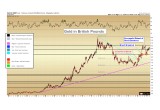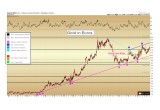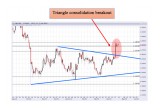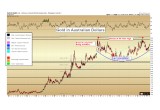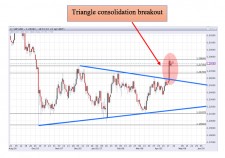
Regarding a review of gold in foreign currencies, the strength of gold price in 2017 is indeed part of a worldwide movement and continues to grow.
Given the turbulence in the world political scene surrounding the French election, saber-rattling between the United States and North Korea, and uncertainty regarding Russian support for Syria, let us take the opportunity this week to update our perspective on gold as priced in major world currencies outside the US dollar. If gold was found to be violating important support levels across the globe, it would give us reason to question the trajectory for US dollar-priced gold at this juncture. Conversely, if gold as priced in foreign currencies remains strong, it would give us reason to anticipate that US dollar gold is set advance when we observe a breakout in the consolidation discussed last week.
British Pound to US Dollar (GBP / USD)
Before we examine gold as priced in British pound sterling, we should note that just last Monday the pound saw an important breakout versus the US dollar. Below we show the GBP / USD cross pair, from the final drop seen last October in the wake of the Brexit vote, through present.
Image A
The breakout higher in GBP / USD occurred on Monday as the pound clearly exceeded the triangle consolidation (blue trendlines) above 1.255 which had formed following the terminal stages of the preceding decline.
This breakout signals a reversal higher in British pound sterling in the works. The initial target for GBP / USD is calculated as 1.318, equal to the amplitude (0.083) of the preceding consolidation added to the apex (off chart, right) of the triangle, at 1.235. It remains to be seen if this reversal develops into a longer-term trend of strength for GBP / USD, but given our suspicion of a multi-year top forming in the US dollar itself, and that GBP represents 11.9% of the dollar index, this breakout should give an initial signal that dollar weakness is likely approaching.
As the strongest periods for precious metals prices tend to correspond with the weakest periods in the US dollar, this breakout in GBP / USD bears monitoring.
[We note here that a reversal higher in GBP is occurring just at the depths of negative sentiment regarding the British pound. Most mainstream media outlets and investment channels have been expecting continued weakness in GBP. As markets so often do, the negative sentiment has already been priced into the current level, and the market has now reversed higher in the opposite direction as prevailing sentiment would seem to dictate.]
Gold in GBP
Turning to gold as priced in GBP, we see that the market still remains defined by the long-term rising linear trendline (magenta), which began in 2005. After breaking the 2011 – 2015 downtrend in a surge to £900 in early 2016, gold then saw a follow-through surge above £900 on the day following the historic Brexit vote.
Note that following the climb to over £1,050, gold then fell right back to £900 in December 2016, successfully retesting that breakout point.
Gold closed last week at £1,006.
We cannot make short-term predictions about GBP-priced gold at this juncture, but the major point of this analysis is to determine if there are red flags as per the worldwide gold market that would give us warning signs as to US dollar-priced gold. We see no technical weakness from the long-term perspective in GBP-gold, and indeed this market looks set to re-challenge the £1,200 all-time high (set in 2011) on the next surge, likely within 12-24 months.
Image B
Gold in Euros (EUR)
Gold as priced in the European common currency continues to look healthy for the continuation of a worldwide bull market, having closed the week at €1,202. We note the continuation of a similar long-term rising trend which began in 2005.
Euro-priced gold broke its 2011 – 2016 downtrend in early 2016, and the advance since then has featured a series of waves, the most recent of which clearly exceeded the prior peak of early 2015 (blue arrows). Lows continue to rise as well, the most recent low coming at €1,070 clearly higher than the early 2016 low of €970, itself clearly higher than the prior two lows of 2014 – 2015 (magenta arrows).
Image D
We will want to see the rising long-term support line hold on any weakness in EUR-gold, just above €1,050. Based on the current trajectory, we can project that EUR-gold will retest its all-time high near €1,400 within the next 24-36 months, or slightly after GBP-gold.
Image C
Gold in Australian Dollars (AUD)
Ironically, although gold priced in Australian dollars has remained stronger on a percentage basis than any of the preceding currencies, AUD-gold is the only one to have broken its rising long-term trendline back in 2013. The old investment adage, “The steeper the trend, the less important the break,” comes to mind here, as since that technical break, Australian dollar-priced gold has been the only gold cross pair of major world currencies to retest its all-time high of $1,850, which it did in mid-2016 (red callout arrows).
The consolidation taking place since 2011 has taken the distinct shape of a cup formation – and it is likely that the retracement back toward $1,550 in December 2016 represented the “handle” of a cup-and-handle technical formation. For reference, the textbook definition of the pattern is shown below (courtesy Investopedia.com):
Upon a break of the $1,850 all-time high, the target for AUD-gold is calculated as $2,400, derived from adding the amplitude of the cup consolidation ($550) to the breakout point.
We continue to anticipate that a breakout to new all-time highs in AUD-gold, for those who monitor such signals, will serve as an early-warning to holders of gold in other major currencies that similar breakouts are pending.
Gold in Canadian Dollars (CAD)
Gold as priced in the Canadian “loonie” is one of the most precise technical markets clearly visible on the charts. CAD-gold closed at $1,740 last week, a mere 8% below the all-time high of $1,900 set in 2011.
Below we show CAD-gold since 2002:
The distinctness of the rising long-term (magenta) trendline should leave no doubts as to its importance.
The low for CAD-gold was in 2013, at $1,250 per ounce. This major low was confirmed by the breakout in late-2014 of the declining trendline since the 2011 all-time high (red callout).
Note the well-defined structure of the rising trend since the 2013 bottom: a series of distinct higher lows and higher highs. The most recent higher low came in December 2016 at just below $1,500.
Gold in Canadian dollars looks healthy from a long-term perspective, and we anticipate it may be the second major world currency, following Australian dollar-gold, to see a new all-time high above the 2011 mark.
Takeaway on Gold in Foreign Currencies
We perform these periodic reviews of gold in foreign currencies to remain cognizant of what is happening across the international investment arena. As a precious metals investor in 2017, you are indeed part of a worldwide movement.
We see no major technical warnings across gold as priced in any of the major western currencies. Initial retests of all-time highs have either already occurred, or they are expected to occur within the next 24 months. Significant advances following lengthy consolidations should be expected upon successful breakouts of these all-time highs.
The strength seen in gold as priced in foreign currencies continues to give us confidence that the worst laggard of the group (yet the most important for the worldwide recognition of a new bull market) – gold in US dollars) – is not far behind.
Christopher Aaron,
Bullion Exchanges Market Analyst
Christopher Aaron has been trading in the commodity and financial markets since the early 2000's. He began his career as an intelligence analyst for the Central Intelligence Agency, where he specialized in the creation and interpretation of the pattern of life mapping in Afghanistan and Iraq.
Technical analysis shares many similarities with mapping: both are based on the observations of repeating and imbedded patterns in human nature.
His strategy of blending behavioral and technical analysis has helped him and his clients to identify both long-term market cycles and short-term opportunities for profit.
Share:

